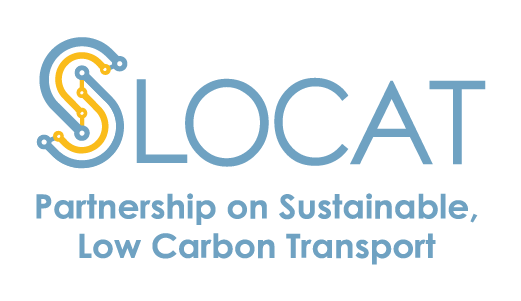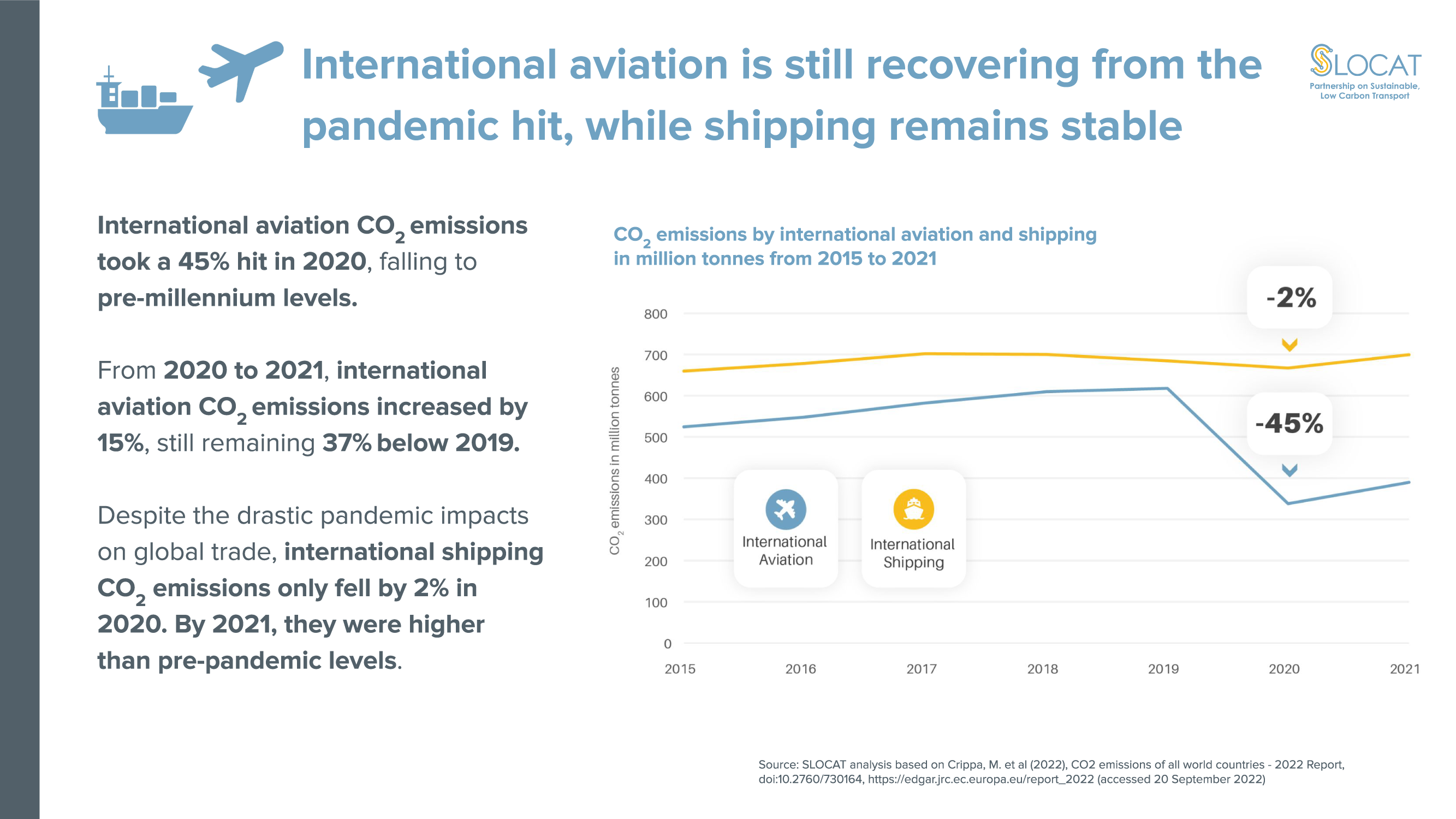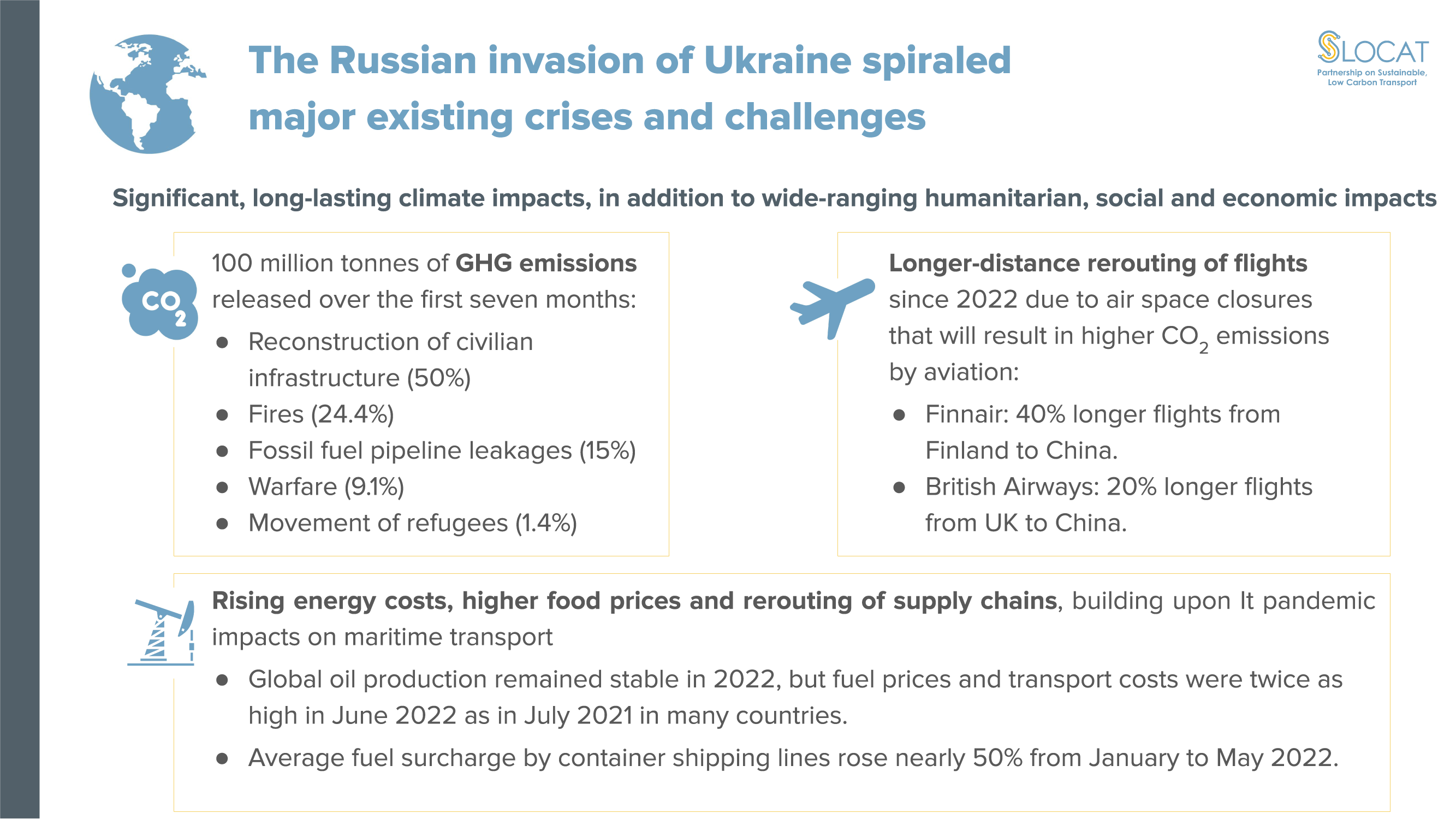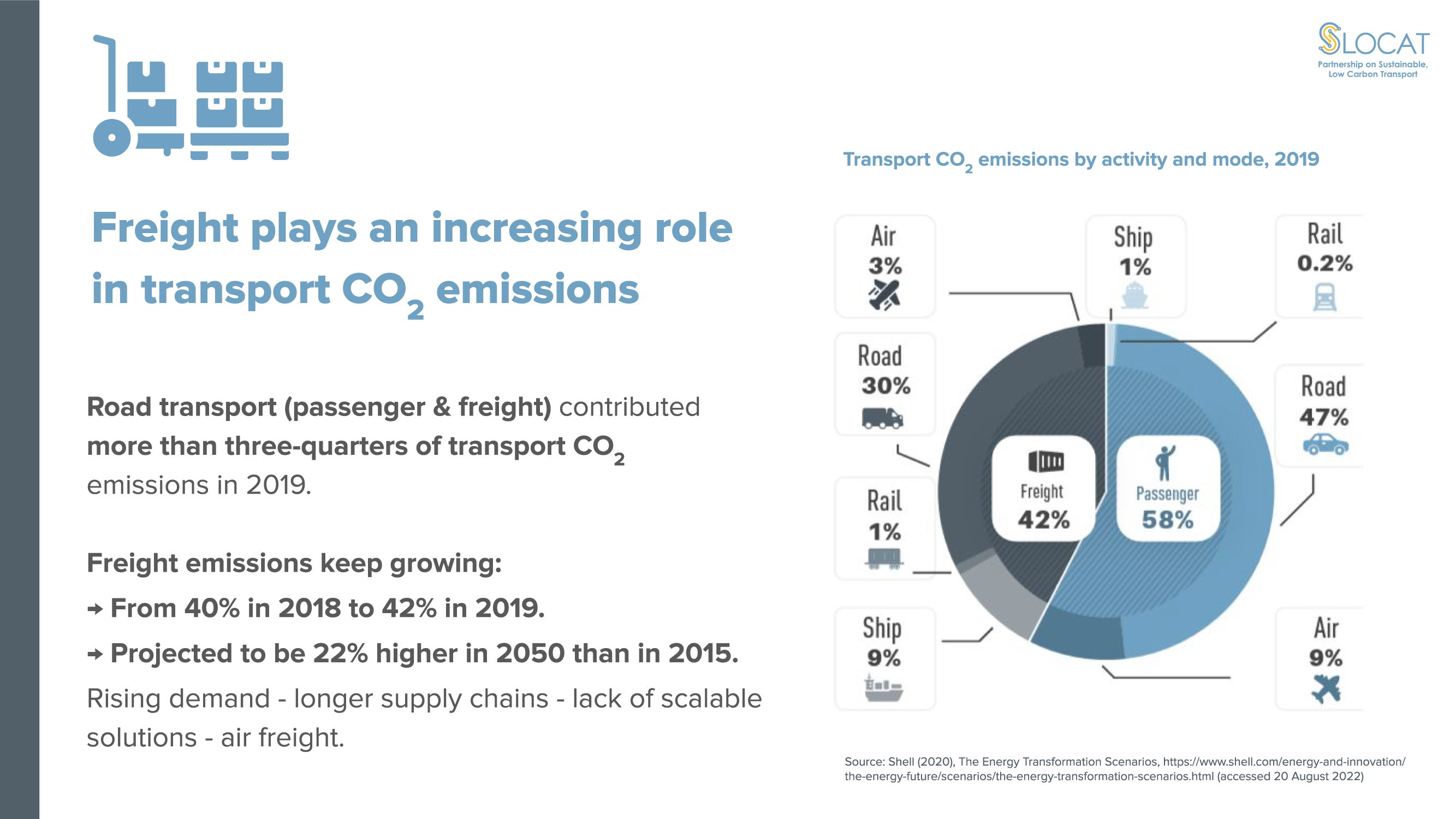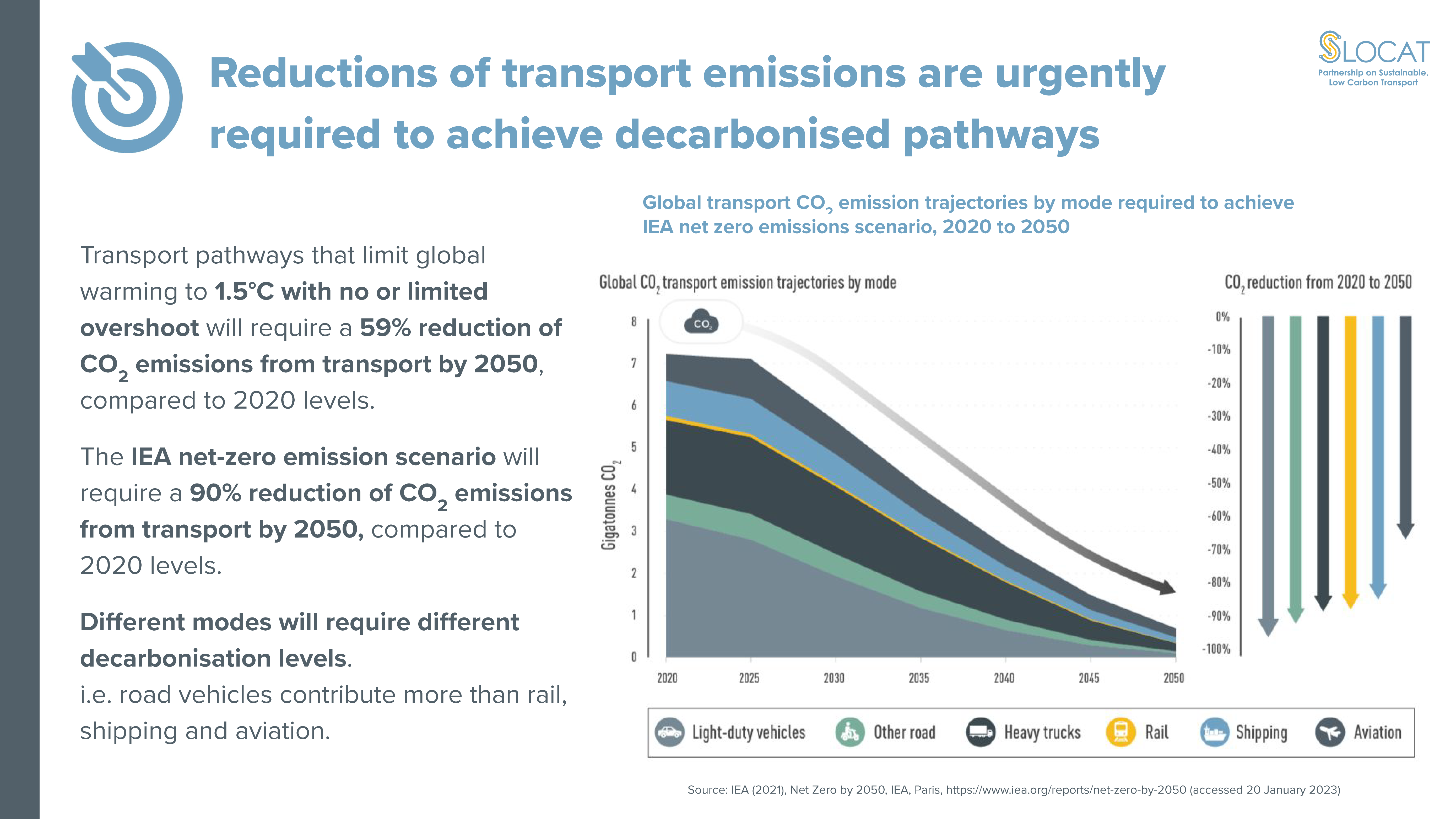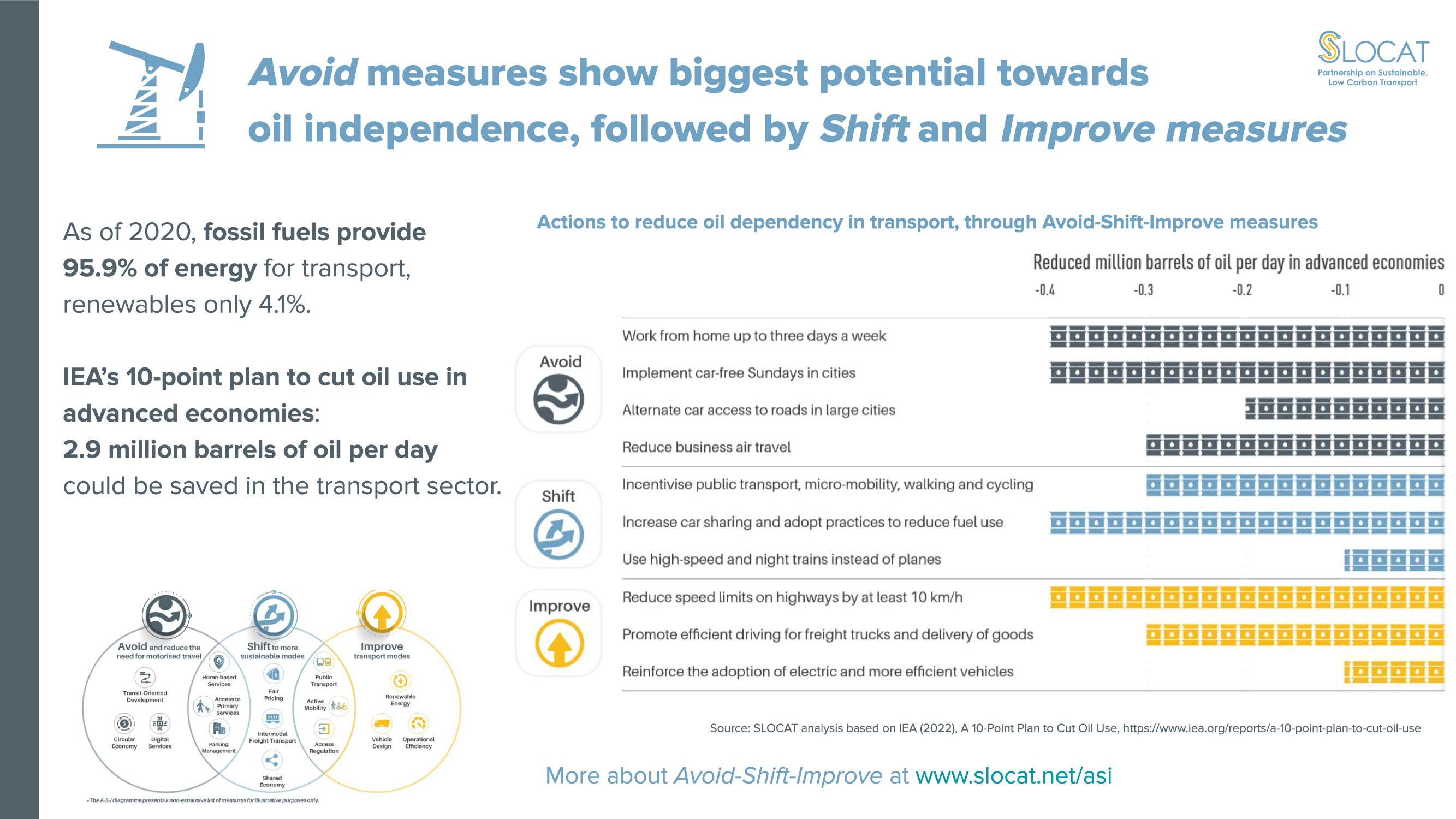-
Transforming Transport and Mobility to Achieve the Targets of the Paris Agreement and the Sustainable Development Goals
- Key Findings
Context and key challenges
- A just transition to equitable, healthy, green, and resilient transport and mobility systems is central to socio-economic prosperity for people and the planet. To achieve this, systemic transformations in transport and mobility – linked to wider socio-economic transformations – are needed.
- The past couple of years have changed the world. Most transport and mobility systems globally have become more vulnerable to systemic shocks, disproportionately affecting people living in vulnerable situations.
- The pandemic and other recent events have led to a greater understanding that decarbonised, resilient, and sustainable transport and mobility systems are an essential service that can increase the social return on investment, reduce the impacts of shocks and speed recovery.
Emission trends
- In November 2022, atmospheric concentrations of carbon dioxide (CO2) reached their highest monthly mean ever recorded, at 417.8 parts per million. Estimates for the year indicate that CO2 emissions hit a record high. Global fossil CO2 emissions exceeded 37.6 gigatonnes in 2019, dropped to 35.6 gigatonnes in 2020, then rose to 37.5 gigatonnes in 2021.
- The Russian Federation’s invasion of Ukraine, which began in February 2022, has had significant, long-lasting impacts on the climate, in addition to its wide-ranging humanitarian, social and economic impacts.
- During 2010-2019, the transport sector had the fastest growth in CO2 emissions among combustion sectors globally, rising 2% annually on average and 18% overall. In 2020, due mainly to the impacts of the COVID-19 pandemic, transport CO2 emissions fell 13%, dropping to 2012 levels. However, emissions nearly completely recovered in 2021 and likely resumed their upward trend in 2022.
- In 2021, high-income countries were responsible for 50.7% of transport CO2 emissions, while low-income countries contributed less than 1%. Per capita transport CO2 emissions have doubled in middle-income countries since 1980, while barely changing in low-income countries.
- During 2010-2021, Asia experienced the highest growth in transport CO2 emissions among regions, at 36%, followed closely by Africa at 34%. In 2021, transport emissions continued to fall in Europe, North America and Oceania, due to the pandemic, but grew in Latin America and the Caribbean.
- In 2019, freight’s share of transport emissions increased to 42%, while passenger transport’s share fell to 58%. Road transport (passenger and freight) contributed 77% of global transport CO2 emissions in 2019.
- Aviation (domestic and international) is responsible for around 4% of the human-induced climate change to date, despite contributing only 2.4% of annual global CO2 emission.
- In 2020, CO2 emissions from international aviation fell 45%, returning to 1999 levels. They then increased 15% in 2021 but were still 37% below 2019 levels. An estimated 1% of the world’s population is responsible for more than half of all CO2 emissions from passenger air travel.
- International shipping produces more transport CO2 emissions than the regions of Africa and Oceania combined. In 2020, CO2 emissions from international shipping fell only 2.6%, and they recovered by 2021 to exceed pre-pandemic levels.
Transport emissions in a business-as-usual scenario
- Under business as usual, global transport activity is projected to nearly double by 2050, rising 1.8 times for passenger transport and 2.0 times for freight transport compared to 2019 levels. Without more ambitious policies, transport CO2 emissions could grow 16-50% by 2050.
- Although countries have made progress in developing long-term visions for addressing climate change in transport, current policies and measures (focused heavily on electrification) are insufficient to put the sector on a decarbonisation pathway in line with the Paris Agreement goal of keeping global temperature rise below 1.5 degrees Celsius (°C).
- Climate action in the transport sector is still deeply insufficient, and countries’ Nationally Determined Contributions (NDCs) under the Paris Agreement that feature transport lack the necessary ambition. Even if the current NDC targets for mitigating transport emissions are met, emissions in the sector will still grow.
Pathways for decarbonising transport
- Total economy-wide greenhouse gas emissions need to peak before 2025 to limit global warming to 1.5°C (with no or limited overshoot).
- Achieving low-carbon transport pathways that limit global warming to 1.5°C will require a 59% reduction in transport-related CO2 emissions by 2050, compared to 2020 levels.
- The maximum increase in passenger transport activity should be 50%, and in freight activity should be 20%, over the 2020-2050 period. Overall, the carbon intensity of the energy used in transport and of the fuels consumed needs to be halved by 2050.
- Fossil fuel dependence in road transport needs to decline drastically, from 95% in 2020 to 10% by 2050, with electricity becoming the dominant fuel in transport by the early 2040.
- In addition to the transition of technologies (“Improve” measures), behavioural changes (“Avoid” and “Shift” measures) are needed to support transport decarbonisation, as emission reductions will not be achieved without critical transitions in transport modes. A 2021 study found that while “Improve” measures can contribute half of the required emission reductions in transport, “Avoid” and “Shift” actions are needed to meet the other half.
- Different regions need to contribute differently to the reduction of transport CO2 emissions, with stronger reductions required in high-income countries than in low- and middle-income countries.
Transforming transport and mobility systems for more sustainable societies
- Achieving equitable, healthy, green, and resilient transport and mobility systems has both explicit and implicit implications for the success of the United Nations’ 2030 Agenda for Sustainable Development and its 17 Sustainable Development Goals (SDGs).
- Since the 2015 adoption of the landmark 2030 Agenda and the Paris Agreement, rising inequalities coupled with the COVID-19 pandemic and geopolitical conflicts have led to significant setbacks in the accomplishment of these agendas and their transport-related targets.
- In a world of interconnected challenges, the opportunity lies in finding solutions for systemic transformation that cut across transport, sustainability and climate action. Applying “Avoid-Shift-Improve” measures across passenger and freight transport through integrated, inter-modal and multi-dimensional approaches remains critical to deliver such cross-cutting solutions.
- Global fossil fuel subsidies have continued to rise, whereas strong financial support is lacking for sustainable, low-carbon transport and mobility options. A fundamental reform of transport economics is urgently needed to deliver the necessary just transformations at the speed and scale required to achieve the targets of the Paris Agreement and the SDGs.
Authors: Maruxa Cardama, Agustina Krapp, Nikola Medimorec, Alice Yiu, SLOCAT Secretariat
